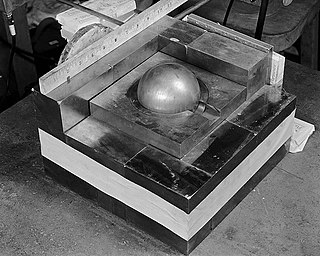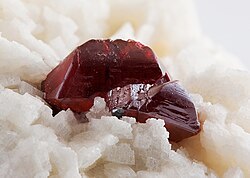
A nuclear weapon is an explosive device that derives its destructive force from nuclear reactions, either fission or a combination of fission and fusion reactions, producing a nuclear explosion. Both bomb types release large quantities of energy from relatively small amounts of matter.

In nuclear physics, a nuclear chain reaction occurs when one single nuclear reaction causes an average of one or more subsequent nuclear reactions, thus leading to the possibility of a self-propagating series or "positive feedback loop" of these reactions. The specific nuclear reaction may be the fission of heavy isotopes. A nuclear chain reaction releases several million times more energy per reaction than any chemical reaction.
A neutron bomb, officially defined as a type of enhanced radiation weapon (ERW), is a low-yield thermonuclear weapon designed to maximize lethal neutron radiation in the immediate vicinity of the blast while minimizing the physical power of the blast itself. The neutron release generated by a nuclear fusion reaction is intentionally allowed to escape the weapon, rather than being absorbed by its other components. The neutron burst, which is used as the primary destructive action of the warhead, is able to penetrate enemy armor more effectively than a conventional warhead, thus making it more lethal as a tactical weapon.

Nuclear technology is technology that involves the nuclear reactions of atomic nuclei. Among the notable nuclear technologies are nuclear reactors, nuclear medicine and nuclear weapons. It is also used, among other things, in smoke detectors and gun sights.
In nuclear engineering, fissile material is material that can undergo nuclear fission when struck by a neutron of low energy. A self-sustaining thermal chain reaction can only be achieved with fissile material. The predominant neutron energy in a system may be typified by either slow neutrons or fast neutrons. Fissile material can be used to fuel thermal-neutron reactors, fast-neutron reactors and nuclear explosives.

Nuclear weapon designs are physical, chemical, and engineering arrangements that cause the physics package of a nuclear weapon to detonate. There are three existing basic design types:

In nuclear engineering, a neutron moderator is a medium that reduces the speed of fast neutrons, ideally without capturing any, leaving them as thermal neutrons with only minimal (thermal) kinetic energy. These thermal neutrons are immensely more susceptible than fast neutrons to propagate a nuclear chain reaction of uranium-235 or other fissile isotope by colliding with their atomic nucleus.

Radiological warfare is any form of warfare involving deliberate radiation poisoning or contamination of an area with radiological sources.

Uranium-235 is an isotope of uranium making up about 0.72% of natural uranium. Unlike the predominant isotope uranium-238, it is fissile, i.e., it can sustain a nuclear chain reaction. It is the only fissile isotope that exists in nature as a primordial nuclide.

Samuel Theodore Cohen was an American physicist who is generally credited as the father of the neutron bomb.
RDS-6s was the first Soviet test of a thermonuclear weapon that occurred on August 12, 1953, that detonated with a force equivalent to 400 kilotons of TNT.

A boosted fission weapon usually refers to a type of nuclear bomb that uses a small amount of fusion fuel to increase the rate, and thus yield, of a fission reaction. The neutrons released by the fusion reactions add to the neutrons released due to fission, allowing for more neutron-induced fission reactions to take place. The rate of fission is thereby greatly increased such that much more of the fissile material is able to undergo fission before the core explosively disassembles. The fusion process itself adds only a small amount of energy to the process, perhaps 1%.

A thermonuclear weapon, fusion weapon or hydrogen bomb (H bomb) is a second-generation nuclear weapon design. Its greater sophistication affords it vastly greater destructive power than first-generation nuclear bombs, a more compact size, a lower mass, or a combination of these benefits. Characteristics of nuclear fusion reactions make possible the use of non-fissile depleted uranium as the weapon's main fuel, thus allowing more efficient use of scarce fissile material such as uranium-235 or plutonium-239. The first full-scale thermonuclear test was carried out by the United States in 1952 and the concept has since been employed by most of the world's nuclear powers in the design of their weapons.
A pure fusion weapon is a hypothetical hydrogen bomb design that does not need a fission "primary" explosive to ignite the fusion of deuterium and tritium, two heavy isotopes of hydrogen used in fission-fusion thermonuclear weapons. Such a weapon would require no fissile material and would therefore be much easier to develop in secret than existing weapons. Separating weapons-grade uranium (U-235) or breeding plutonium (Pu-239) requires a substantial and difficult-to-conceal industrial investment, and blocking the sale and transfer of the needed machinery has been the primary mechanism to control nuclear proliferation to date.

Gun-type fission weapons are fission-based nuclear weapons whose design assembles their fissile material into a supercritical mass by the use of the "gun" method: shooting one piece of sub-critical material into another. Although this is sometimes pictured as two sub-critical hemispheres driven together to make a supercritical sphere, typically a hollow projectile is shot onto a spike, which fills the hole in its center. Its name is a reference to the fact that it is shooting the material through an artillery barrel as if it were a projectile.

Orange Herald was a British nuclear weapon, tested on 31 May 1957. At the time it was reported as an H-bomb, although in fact it was a large boosted fission weapon and remains to date, the largest fission device ever detonated.
Reactor-grade plutonium (RGPu) is the isotopic grade of plutonium that is found in spent nuclear fuel after the uranium-235 primary fuel that a nuclear power reactor uses has burnt up. The uranium-238 from which most of the plutonium isotopes derive by neutron capture is found along with the U-235 in the low enriched uranium fuel of civilian reactors.

A fizzle occurs when the detonation of a device for creating a nuclear explosion grossly fails to meet its expected yield. The bombs still detonate, but the detonation is much less than anticipated. The cause(s) for the failure can be linked to improper design, poor construction, or lack of expertise. All countries that have had a nuclear weapons testing program have experienced some fizzles. A fizzle can spread radioactive material throughout the surrounding area, involve a partial fission reaction of the fissile material, or both. For practical purposes, a fizzle can still have considerable explosive yield when compared to conventional weapons.

In nuclear weapon design, the pit is the core of an implosion nuclear weapon, consisting of fissile material and any neutron reflector or tamper bonded to it. Some weapons tested during the 1950s used pits made with uranium-235 alone, or as a composite with plutonium. All-plutonium pits are the smallest in diameter and have been the standard since the early 1960s. The pit is named after the hard core found in stonefruit such as peaches and apricots.

Nuclear transmutation is the conversion of one chemical element or an isotope into another chemical element. Nuclear transmutation occurs in any process where the number of protons or neutrons in the nucleus of an atom is changed.














